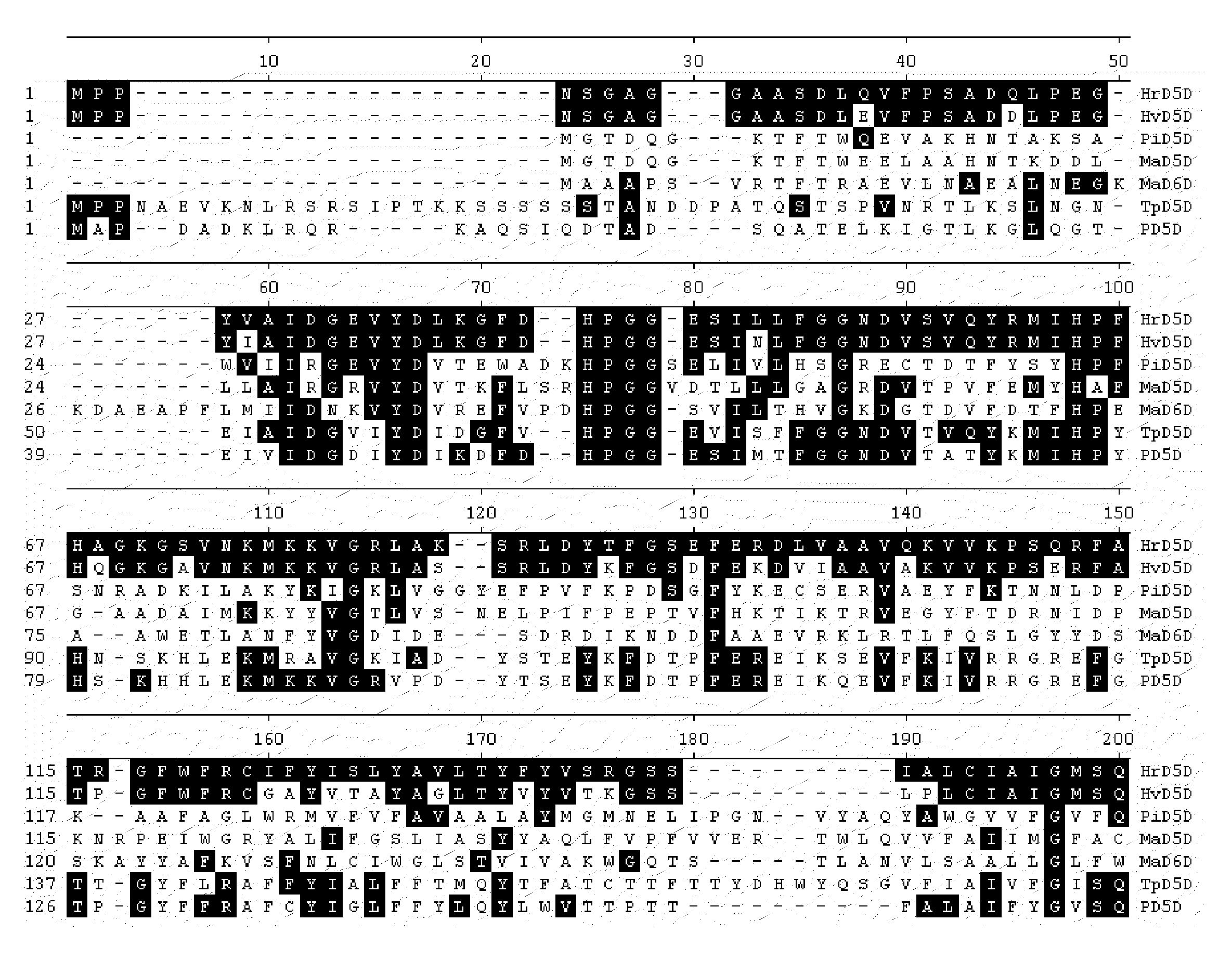UTILIZATION OF FATTY ACID DESATURASES FROM Hemiselmis spp.
- Summary
- Abstract
- Description
- Claims
- Application Information
AI Technical Summary
Benefits of technology
Problems solved by technology
Method used
Image
Examples
example 1
Cloning of Hemiselmis Δ5 Desaturase Sequences
[0112]The Δ5 desaturases of the current invention were cloned from Hemiselmis virescens and Hemiselmis rufescens. To clone the Hemiselmis virescens Δ5 desaturase (HvD5D), RNA was isolated from H. virescens CCMP442 (CCMP, West Boothbay Harbor, Me., USA) followed by the construction of a cDNA library. Approximately 20,000 independent clones were sequenced. Searching for desaturase-related sequences yielded a putative Δ5 desaturase-encoding clone, LIB5446-048-A1-M1-G2.
[0113]The DNA sequence of the cloned insert for LIB5446-048-A1-M1-G2 (SEQ ID NO: 5) was 1613 by in length and contained an open reading frame (ORF) of 1326 by (SEQ ID NO: 1), encoding a deduced amino acid sequence of 441 amino acids (SEQ ID NO: 2). The calculated size of the protein is 48.9 Kdal with an estimated pI of 7.1. The ORF, referred to as HvD5D, contained the conserved amino acid sequence HPGG (SEQ ID NO: 24), which is part of the cytochrome b5 (cytb5) domain fused to ...
example 2
Yeast Transformation and Expression
[0118]The pYES2.1 / V5-His-TOPO® clones containing HvD5D and HrD5D were introduced into the host strain Saccharomyces cerevisiae INVSc1 (auxotrophic for uracil) (Invitrogen) using the S.C. EasyComp™ Transformation Kit (Invitrogen). Transformants were selected on plates made of SC minimal media minus uracil with 2% glucose. Colonies of transformants were used to inoculate 2 ml of SC minimal media minus uracil and 2% glucose grown overnight at 30° C. For induction, stationary phase yeast cells were pelleted and re-suspended at 0.4 O.D. A600 in SC minimal media minus uracil supplemented with 2% galactose and optional exogenous fatty acids and grown for 3 days at 15° C. When exogenous fatty acids were provide to the cultures, either 0.01% DGLA (18:2 Δ8, 11, 14) or 0.01% ETA (20:4 Δ8, 11, 14, 17) was added with 0.1% of the emulsifier Tergitol. The cultures were harvested by centrifugation after 3 days of incubation with these fatty acids. Cell pellets wer...
example 3
Expression of the Hemiselmis Spp. Δ5 Desaturases in Soybean and Canola
[0121]The activity of the Hemiselmis virescens or the Hemiselmis rufescens Δ5 desaturase is evaluated in soybean by expressing it under the control of seed-enhanced promoter in a soybean background that contains expression cassettes for other fatty acid desaturases which produce the dihomo-γ-linolenic acid (DGLA) and / or eicosatetraenoic acid (ETA) substrate fatty acid molecules that the Δ5 desaturase transforms into arachidonic acid (ARA) or eicosapentaenoic acid (EPA), respectively. Seed-enhanced expression of transgenes in plants in general and in soybean specifically is well established in the art. Using standard molecular cloning techniques the gene of interest is cloned either as wild-type sequence or as a sequence codon-enhanced for expression for the plant of interest downstream of a seed-enhanced promoter. Examples for seed-enhanced promoters of dicotyledonous plants such as soybean or canola are the 7Sα p...
PUM
| Property | Measurement | Unit |
|---|---|---|
| Temperature | aaaaa | aaaaa |
| Fraction | aaaaa | aaaaa |
| Fraction | aaaaa | aaaaa |
Abstract
Description
Claims
Application Information
 Login to View More
Login to View More - R&D
- Intellectual Property
- Life Sciences
- Materials
- Tech Scout
- Unparalleled Data Quality
- Higher Quality Content
- 60% Fewer Hallucinations
Browse by: Latest US Patents, China's latest patents, Technical Efficacy Thesaurus, Application Domain, Technology Topic, Popular Technical Reports.
© 2025 PatSnap. All rights reserved.Legal|Privacy policy|Modern Slavery Act Transparency Statement|Sitemap|About US| Contact US: help@patsnap.com



